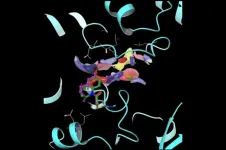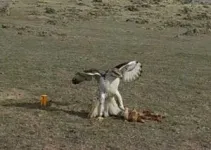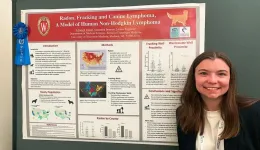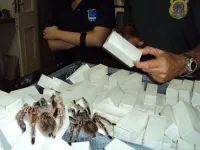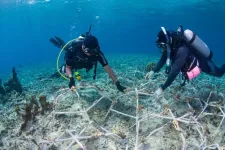(Press-News.org) Helicases are enzymes that unwind DNA and RNA. They’re central to cellular life, implicated in a number of cancers and infections—and, alas, extraordinarily difficult to target with drugs.
Now, new research provides a powerful platform for designing covalent inhibitors tailored to target helicases. The paper, published in the Journal of the American Chemical Society, describes how researchers used this innovative new platform to design molecules that take aim at helicases involved in COVID and certain cancers.
“High-resolution structural and biochemical data alone are not sufficient for finding druggable sites in conformationaly dynamic enzymes such as helicases,” says Rockefeller’s Tarun Kapoor. “Our approach can identify these sites and also provide chemical starting points for developing drugs that target helicases.”
Mechanical difficulties
Complex molecular machines that traverse DNA and RNA strands, helicases must kickstart the unraveling process that prepares genetic information for processes such as replication or transcription. But when helicases go rogue, they can promote the growth of some cancers. At the same time, helicases are also crucial for viral replication and bacterial proliferation. It follows that different drugs targeting these enzymes could treat certain cancers, or stop infections in their tracks.
“Helicases are very hot targets right now,” says lead author Jared Ramsey, a graduate student in the Kapoor lab. “Drugs that inhibit helicases are of great interest to the scientific community, and could be leveraged as new and effective treatments.”
Helicase inhibitors, however, are hard to come by. By testing thousands of small molecules, drug companies have occasionally happened upon methods for grinding one helicase or another to a halt, but these occurences have proven rare. “The same was true in our lab,” Ramsey says. “We were unable to identifiy helicase inhibitors using typical approaches such as high-throughput screening.”
Ramsey, Kapoor, and colleagues wondered whether electrophilic small molecules could be used to scout out the weak points in a helicase, quietly prodding the enzyme for potential binding sites susceptible to drugs. Central to this idea is the concept of covalency, where inhibitor candidates irreversibly bind the helicase target, possibly circumventing complications from the dynamic and fluid nature of these enzymes. To that end, the team selected two innocuous molecules and directed the so-called scout fragments toward a helicase of SARS-CoV-2.
Once they found likely binding sites on the helicase, they promoted the scouts to soldiers. “We just had to take a minimally elaborated electrophilic molecule, identify where it binds with mass spectrometry, and then use medicinal chemistry to modify it and screen a few versions of to achieve a potent, specific inhibitor,” Ramsey says.
The team also demonstrated that scout fragments could be tuned to shut down two specific helicases, BLM and WRN, which are implicated in Bloom Syndrome and Werner Syndrome, respectively, as well as a number of cancers. While the published findings aren’t expected to immediately translate into drugs that treat COVID or cancer, they do serve as a valuable starting point for drug developers to make bespoke helicase targets.
“Our findings show how the platform we developed could accelerate work in other labs,” Ramsey says. “We take a basic science approach, and that’s how many useful findings are uncovered. This takes a challenging problem and gives us a solid place to start.”
END
Rogue enzymes cause numerous diseases. A new method could help design drugs to treat them.
2024-03-08
ELSE PRESS RELEASES FROM THIS DATE:
Study shows how oestrogen protects against fatty liver
2024-03-08
New research from Karolinska Institutet in Sweden shows how oestrogen protects against MASLD, a fatty liver disease that has increased dramatically during the current obesity epidemic. The study, published in Molecular Systems Biology, shows how a new drug under development could become a future treatment for fatty liver disease and liver cancer.
The global obesity epidemic has resulted in a dramatic increase in fatty liver, a disease in which fat that does not fit into fat cells is stored in liver cells instead.
Since last year, fatty liver due to obesity (and not excessive alcohol consumption) is known as MASLD (metabolic dysfunction-associated steatotic liver disease). ...
Limited correlation between canine lymphoma and proximity to environmental toxins in new study
2024-03-08
DENVER/March 8, 2024 – As awareness of the health risks associated with radon and fracking exposure in connection to cancer continues to rise in human medicine, a recent study explored these ties with multicentric lymphoma, a prevalent canine cancer. Surprisingly, the study did not identify significant correlations between living near sources of environmental toxins, such as fracking by-products and radon, and dogs diagnosed with lymphoma.
The results of this study were published on Monday using data from Morris Animal Foundation’s Golden Retriever Lifetime Study, which enrolled dogs with multicentric lymphoma and matched unaffected ...
Bald eagles eat prairie dogs? Researchers underscore relationship between raptors and rodents in the southern plains
2024-03-08
We all know that bald eagles like fish. Few of us, however, picture them soaring over grasslands seeking out prairie dog snacks. In a new paper from the Journal of Raptor Research, lead author Courtney Duchardt and coauthors make the case that prairie dogs are an important resource for at least four species of raptors overwintering in the Southern Great Plains, bald eagles included. Their paper, titled “Overwintering Raptor Abundance and Community Composition in Relation to Prairie Dog Colonies in the Southern Great Plains,” explains the first broad scale look into the relationship between prairie dogs and their aerial predators, and illuminates ...
Facing illegal wildlife trade in the European union: A call for comprehensive measures
2024-03-08
New paper now published in Science proposes three measures the European Union should implement to improve open information, legality and sustainability of wildlife trade in the region.
Wildlife trade affects all kinds of species, from insects and fungi to large plants and mammals. The global trade of numerous species poses a significant threat to their survival, increasing their risk of extinction. The European Union is a major global hub for the illegal and unsustainable trade of those species whose international trade is not regulated by the Convention on International Trade in Endangered ...
A better handle on the emissions budget for the Paris climate targets
2024-03-08
A team of scientists from the University of Exeter, Met Office and Imperial College have found a new way to calculate the total carbon emissions consistent with the Paris climate targets of 1.5oC and 2oC of global warming.
Although the exceptionally warm climate in 2023 was close to exceeding the 1.5oC level, the Paris targets relate to the average warming over ten or more years.
The new study answers the question: how much carbon have we got left before we pass the Paris limits?
About 15 years ago, climate scientists discovered a remarkably useful fact about climate change.
Despite the vast complexity ...
High cholesterol was twice as prevalent among American Indian teens and young adults
2024-03-08
Research Highlights:
A study of more than 1,400 people in U.S. tribal communities found that high cholesterol was twice as prevalent among American Indian adolescents and young adults compared to the overall U.S. population.
The study also noted that few study participants with high cholesterol sought or received treatment during the study period.
DALLAS, March 8, 2024 — Young American Indians, ages 15-39, had cholesterol levels more than two times higher than the general U.S. population, according to new research published in the Journal of the American Heart Association, an open access, peer-reviewed journal of the American ...
Good news for coral reef restoration efforts: Study finds “full recovery” of reef growth within four years
2024-03-08
While the majority of the world’s reefs are now under threat or even damaged potentially beyond repair, a new study reported in the journal Current Biology on March 8 offers some encouraging news: efforts to restore coral reefs not only increase coral cover, but they can also bring back important ecosystem functions, and surprisingly fast.
“We found that restored coral reefs can grow at the same speed as healthy coral reefs just four years after coral transplantation,” says Ines Lange (@InesLange9) of University of Exeter, UK. “This means that they provide lots of habitat for ...
Balancing training data and human knowledge makes AI act more like a scientist
2024-03-08
When you teach a child how to solve puzzles, you can either let them figure it out through trial and error, or you can guide them with some basic rules and tips. Similarly, incorporating rules and tips into AI training—such as the laws of physics—could make them more efficient and more reflective of the real world. However, helping the AI assess the value of different rules can be a tricky task.
Researchers report March 8 in the journal Nexus that they have developed a framework for assessing the ...
Restored coral reefs can grow as fast as healthy reefs
2024-03-08
Planting new coral in degraded reefs can lead to rapid recovery – with restored reefs growing as fast as healthy reefs after just four years, new research shows.
Reefs worldwide are severely threatened by local and global pressures. In Indonesia, where the study was carried out, destructive blast fishing destroyed large reef areas 30-40 years ago – with no signs of recovery until now.
The Mars Coral Reef Restoration Programme attempts to restore degraded reefs by transplanting coral fragments onto a network of interconnected ...
Continuous Medicaid eligibility during the pandemic and postpartum coverage, health care, and outcomes
2024-03-08
About The Study: In this study including 47,000 participants, continuous Medicaid eligibility during the COVID-19 pandemic significantly reduced loss of Medicaid after birth, suggesting similar uninsurance reductions may be expected from post-pandemic postpartum Medicaid extensions, which most states plan to implement.
Authors: Jamie R. Daw, Ph.D., of the Columbia University Mailman School of Public Health in New York, is the corresponding author.
To access the embargoed study: Visit our For The Media website at this link https://media.jamanetwork.com/
(doi:10.1001/jamahealthforum.2024.0004)
Editor’s ...
